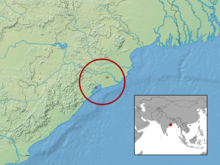This article includes a list of general references, but it lacks sufficient corresponding inline citations. (January 2009) |
| Chilka spotted skink | |
|---|---|
| Scientific classification | |
| Domain: | Eukaryota |
| Kingdom: | Animalia |
| Phylum: | Chordata |
| Class: | Reptilia |
| Order: | Squamata |
| Family: | Scincidae |
| Genus: | Barkudia |
| Species: | B. insularis
|
| Binomial name | |
| Barkudia insularis Annandale, 1917
| |

| |

Barkudia insularis, commonly known as the Madras spotted skink, is a critically endangered limbless skink which was described in 1917 by Nelson Annandale and rediscovered in the wild in 2003. Little is known about the species but it was previously believed to be found only in the mangrove habitats near Barkuda Island in Chilka Lake, Odisha, India.[2] Later observations in adjoining parts of Odisha indicate a larger range within the state.[3] The lizard looks like a large earthworm and lives in the subsoil and probably feeds on small arthropods.
The holotype was found in loose earth near the roots of a banyan tree of Badakuda Island of Chilka lake in 1917. Only four reports of the species have been made since its description, all within Odisha: observations in 1917 and 2003 at Barkuda Island in Chilka Lake, a 1979 observation in Nandankanan Zoological Park, and a 2022 observation made near the vicinity of Buguda. The 2022 observation marked the first photograph taken of a live individual of the species.[3]
- ^ Bauer, A.; Srinivasulu, C.; Srinivasulu, B.; Roy, A.D.; Murthy, B.H.C.K.; Molur, S.; Pal, S.; Mohapatra, P.; Agarwal, I.; Sondhi, S. (2020). "Barkudia insularis". IUCN Red List of Threatened Species. 2020: e.T2593A176084098. doi:10.2305/IUCN.UK.2020-3.RLTS.T2593A176084098.en. Retrieved 20 November 2021.
- ^ Behera, P.K. "Ecotech Education and Ecosystem Conservation of the Lake Chilika, Orissa" (PDF).
{{cite journal}}: Cite journal requires|journal=(help) - ^ a b Singha, Minati (March 15, 2022). "Rare, endangered legless lizard spotted for 4th time since 1917 in Odisha". The Times of India. Retrieved 2023-01-11.
